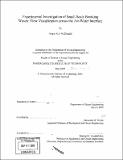| dc.contributor.advisor | Alexandra H. Techet. | en_US |
| dc.contributor.author | McDonald, Angus Kai | en_US |
| dc.contributor.other | Massachusetts Institute of Technology. Dept. of Ocean Engineering. | en_US |
| dc.date.accessioned | 2006-07-31T15:13:45Z | |
| dc.date.available | 2006-07-31T15:13:45Z | |
| dc.date.copyright | 2005 | en_US |
| dc.date.issued | 2005 | en_US |
| dc.identifier.uri | http://hdl.handle.net/1721.1/33572 | |
| dc.description | Thesis (S.M.)--Massachusetts Institute of Technology, Dept. of Ocean Engineering, 2005. | en_US |
| dc.description | Includes bibliographical references (p. 137-140). | en_US |
| dc.description.abstract | The dynamics of breaking waves significantly affect air-sea fluxes of heat, momentum, mass and energy across the ocean interface. Breaking waves also contribute considerable loading to offshore and coastal structures, and furthermore, the quasi-steady bow wave on a ship increases drag and ease of detection by the bubbly wake. However, the complexity of the phenomenon has severely limited our ability to describe it and predict its occurrence. Research has typically involved field observations, controlled laboratory studies, and numerical simulations. A recent simulation presented new information about local energy dissipation and the coupled air-water effects of small breaking waves. In light of these findings, the objective of this thesis is to experimentally study small-scale breaking waves and examine the combined air-water flow fields using advanced visualization techniques. This research was performed in a narrow wavetank which was 2.5m long. Waves were generated with a hinged paddle and breaking occurred as the train propagated up a 15 degree slope to a level plateau. Waves were studied using surface piercing wave probes, high speed video, and Particle Image Velocimetry (PIV). | en_US |
| dc.description.abstract | (cont.) Surface tension was found to have a significant effect on the breaking dynamics at this scale. After a thorough exploration of its effect on surface tension, isopropyl alcohol was added to distilled water in a 10% solution by volume, which reduced the surface tension to approximately 43 dynes/cm. A wave breaking database was created which included 26 different wave trains over a frequency band of 1.5-4Hz. The corresponding Weber numbers ranged from 400 through 14,600 with Reynolds numbers from 38,200 through 280,000. The wave probes measured significant potential energy losses to breaking which are expected. The air- water flow fields are studied by seeding the air and water with reflective particle and processing the video results with PIV software. Qualitative results from PIV including vector and vorticity maps agree well with previous theory and recent numerical results. | en_US |
| dc.description.statementofresponsibility | by Angus Kai McDonald. | en_US |
| dc.format.extent | 140 p. | en_US |
| dc.format.extent | 8533766 bytes | |
| dc.format.extent | 8539663 bytes | |
| dc.format.mimetype | application/pdf | |
| dc.format.mimetype | application/pdf | |
| dc.language.iso | eng | en_US |
| dc.publisher | Massachusetts Institute of Technology | en_US |
| dc.rights | M.I.T. theses are protected by copyright. They may be viewed from this source for any purpose, but reproduction or distribution in any format is prohibited without written permission. See provided URL for inquiries about permission. | en_US |
| dc.rights.uri | http://dspace.mit.edu/handle/1721.1/7582 | |
| dc.subject | Ocean Engineering. | en_US |
| dc.title | Experimental investigation of small-scale breaking waves : flow visualization across the air-water interface | en_US |
| dc.type | Thesis | en_US |
| dc.description.degree | S.M. | en_US |
| dc.contributor.department | Massachusetts Institute of Technology. Department of Ocean Engineering | |
| dc.identifier.oclc | 63516938 | en_US |
